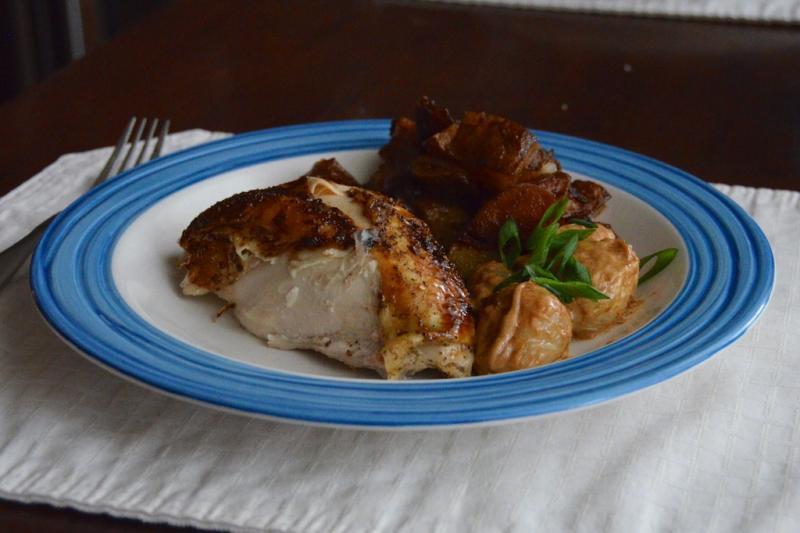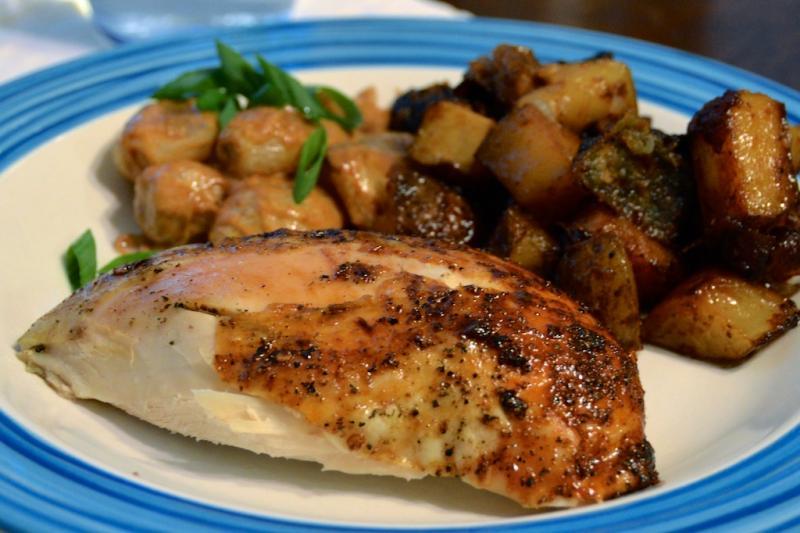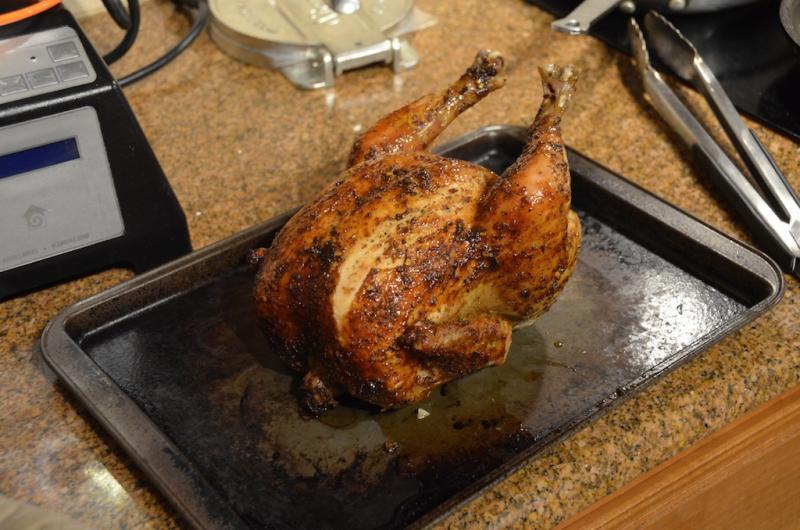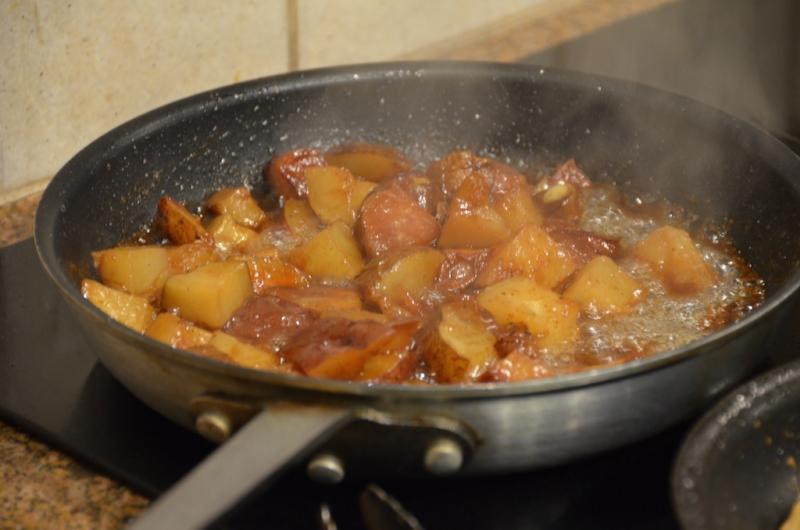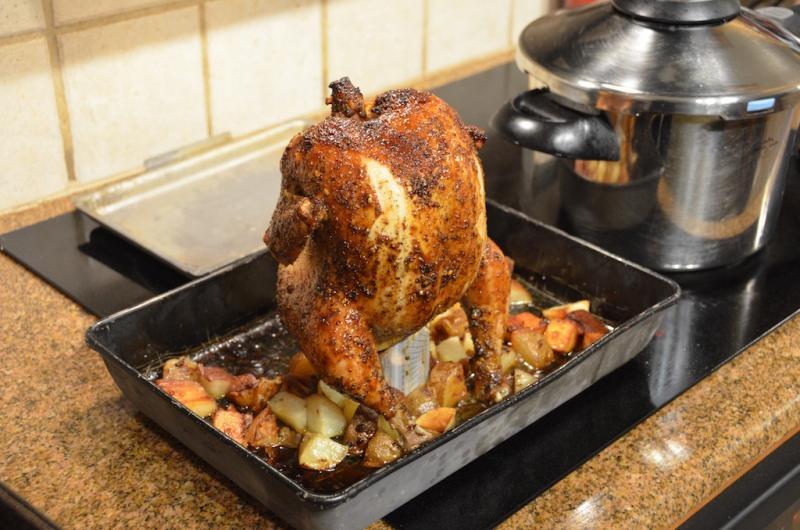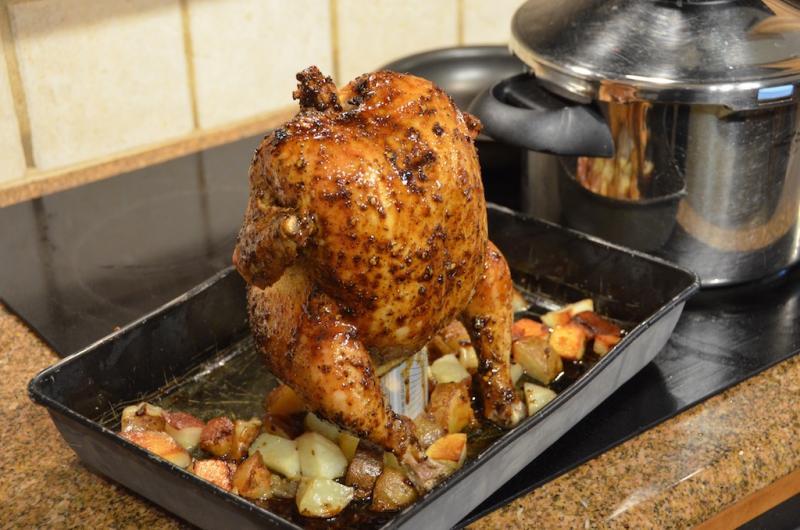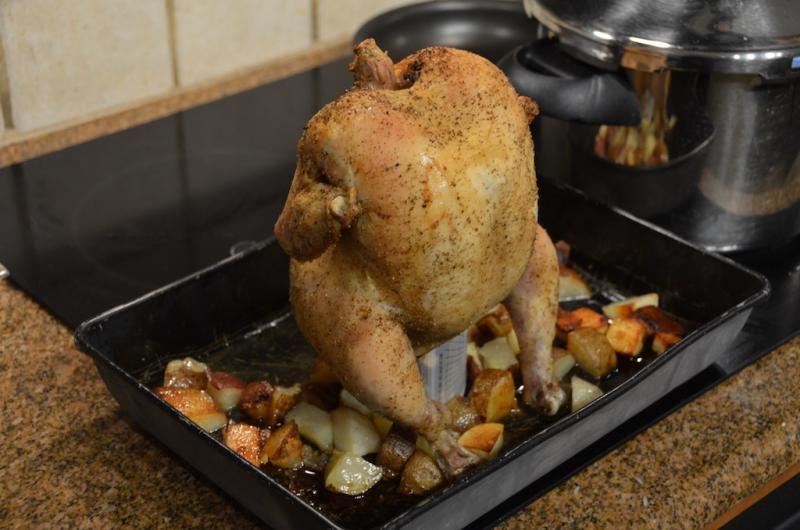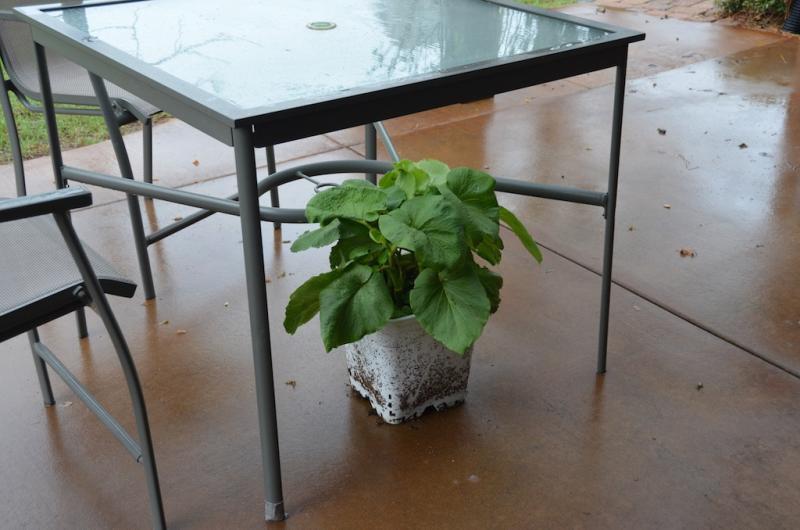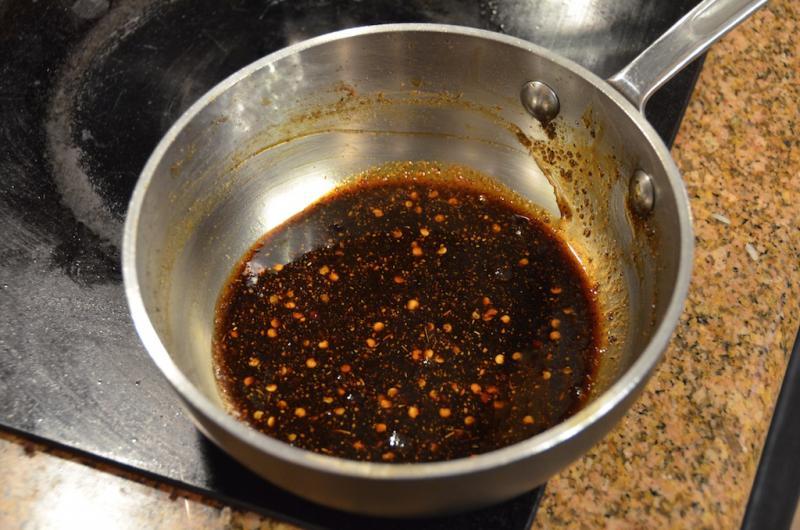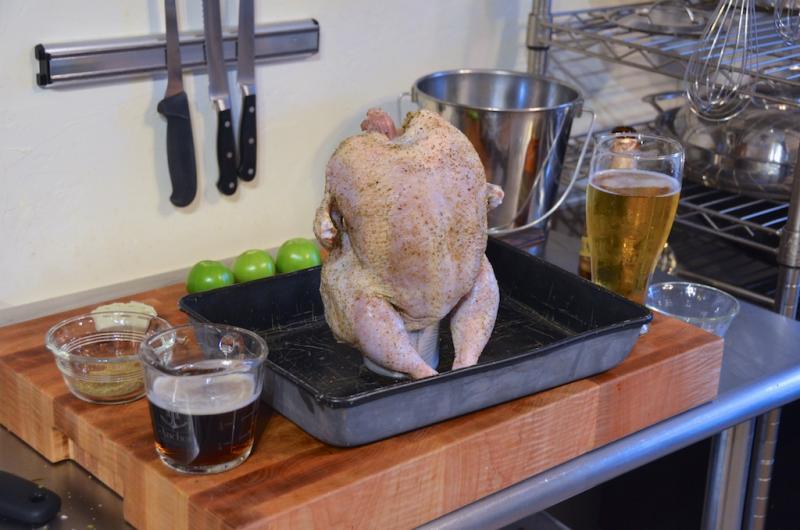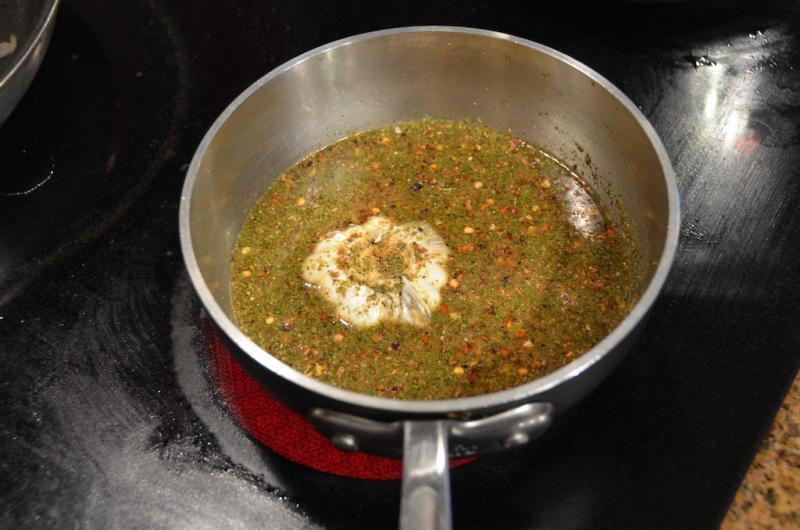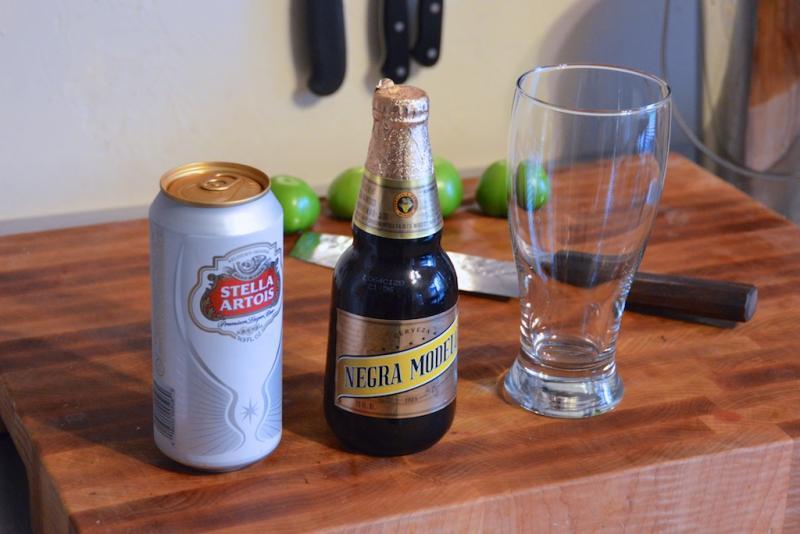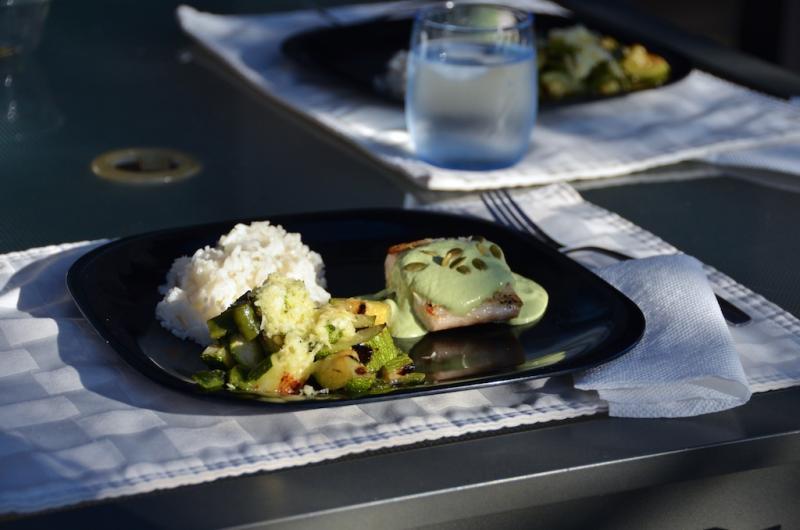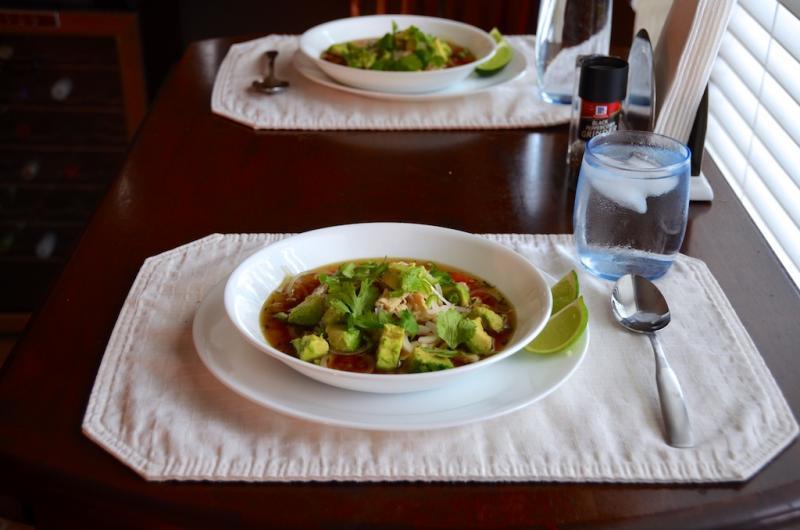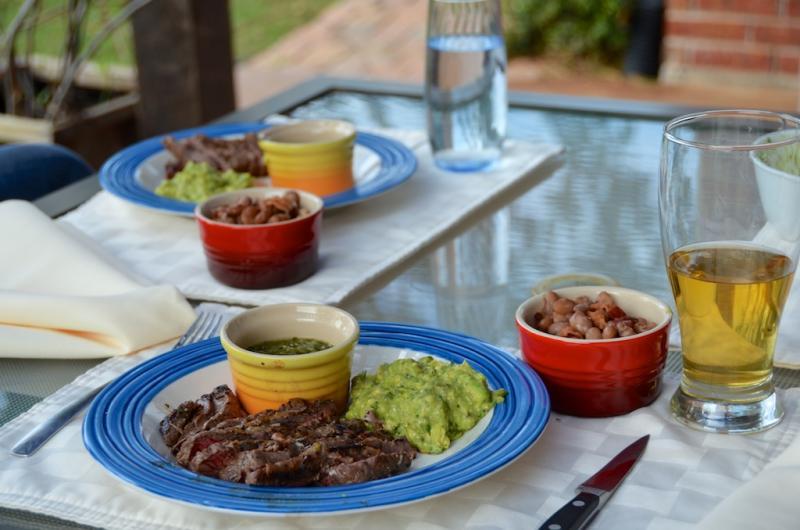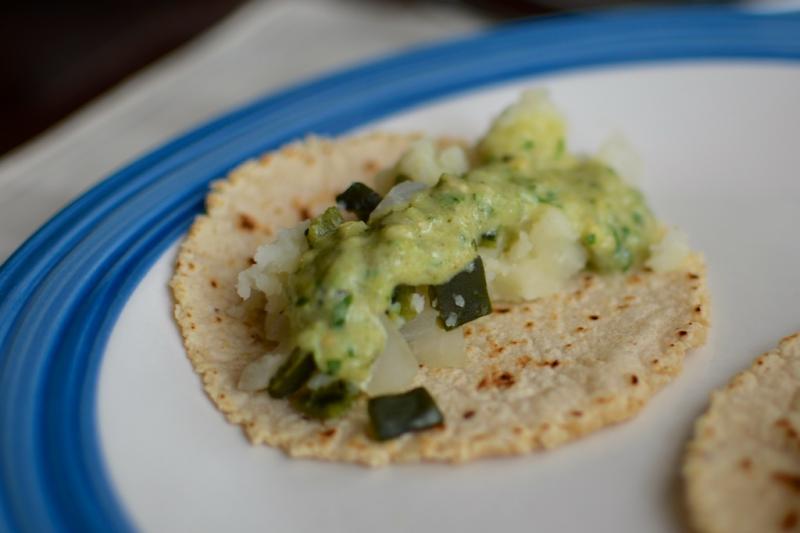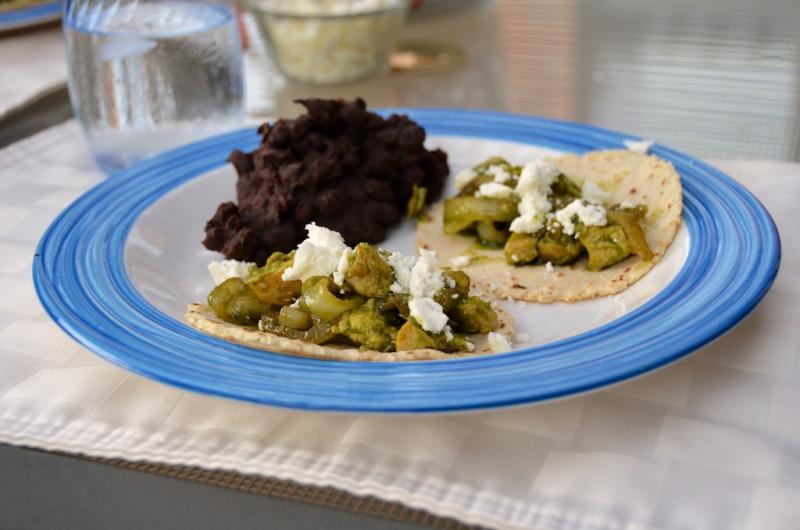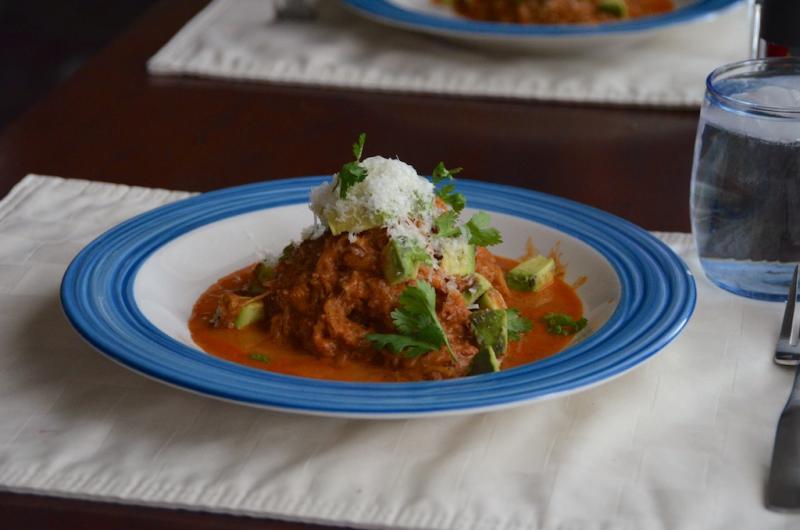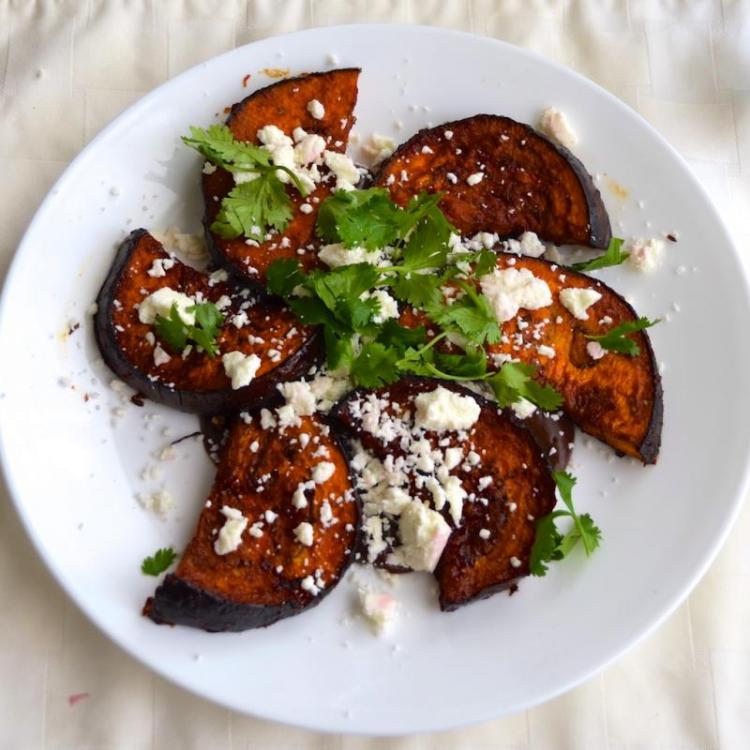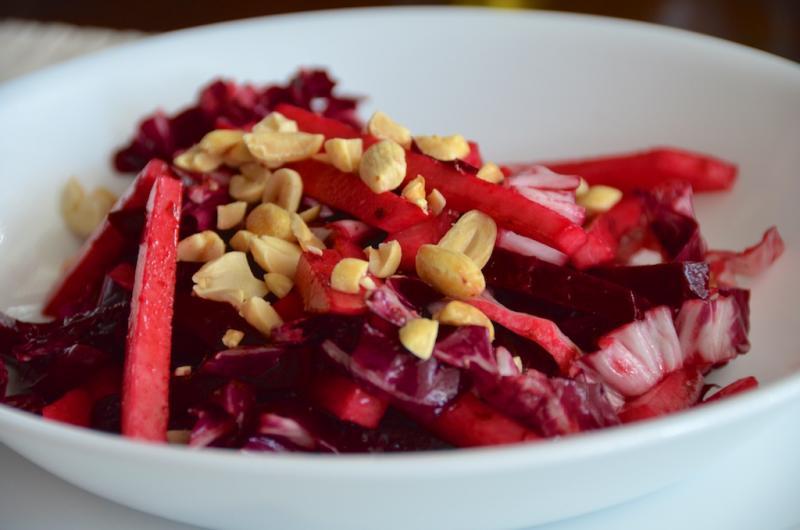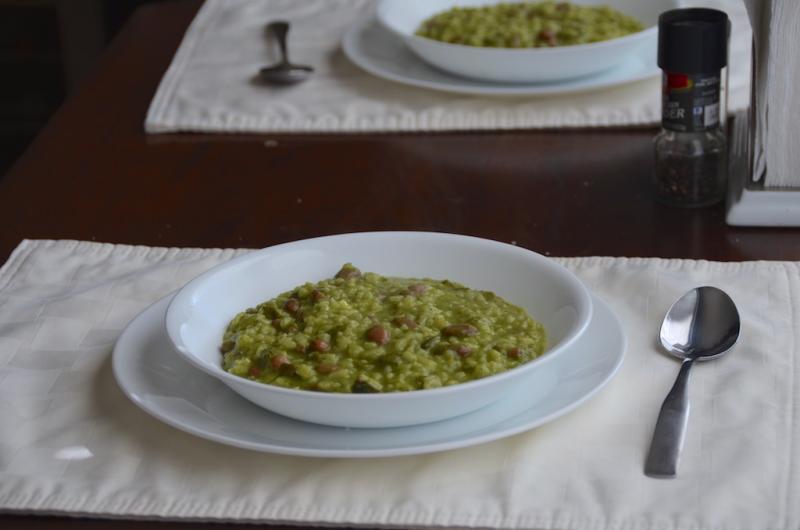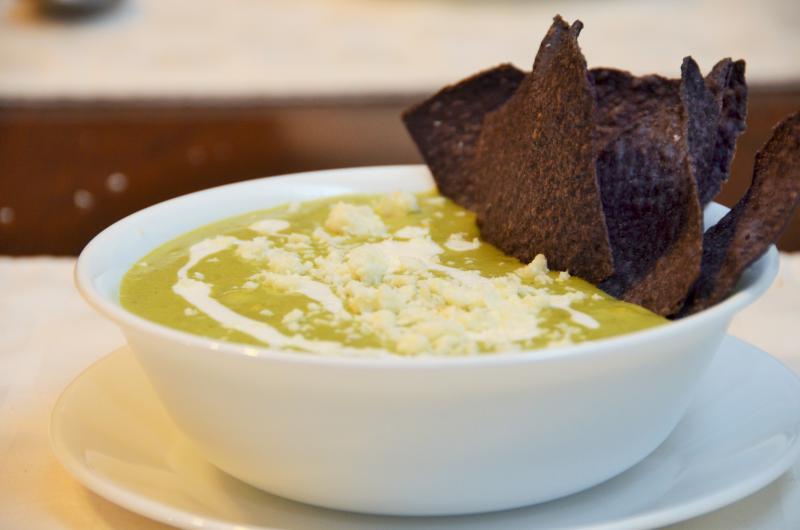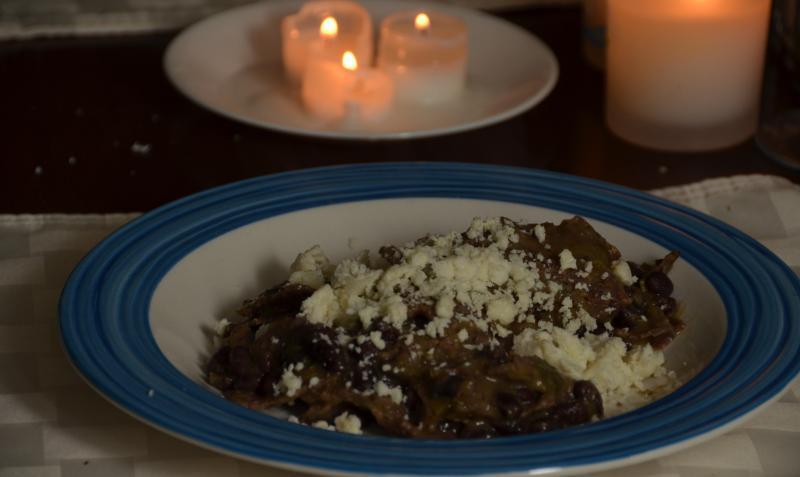-
Posts
10,190 -
Joined
-
Last visited
Content Type
Profiles
Forums
Store
Help Articles
Everything posted by Chris Hennes
-
Darienne, have you tried letting your tomatillos self-seed? I planted them once a few years ago, and have never had to buy seed since, they just come up because of the fruit I leave on at the end of the season.
-
(Addendum: you can see some in process photos of the dish in the Cooking with Beer cookoff here and here)
-
Beer-Glazed Beer-Can Chicken (p. 327) Roasted Knob Onions with Crema and Aged Mexican Cheese (p. 154) I've actually never made beer can chicken before: honestly, I never saw the point. If I want to flavor a chicken with something, I find that rubs, marinades, and brines are much more effective than any additions to the bird's cavity. I may have to reconsider that position in light of tonight's meal, but that reconsideration has nothing to do with the chicken. I could detect no hint of any sort of beer or spice taste in the flesh. The glaze is on the surface of the bird, which of course you can taste (at least if you are eating the skin) and is indeed delicious. But the real winner here was the potatoes. Bayless lists surrounding the cooking bird with vegetables as optional, but rest assured, it is not. The last step of cooking is to empty the contents of the beer can onto the vegetables while the chicken is resting, and reduce it to a glaze. The effect was amazing, these are just about the best roasted potatoes I can remember. I didn't add any other vegetables to the mix because I was also making the glazed onions separately. I'm sure onions, carrots, and parsnips would all be fantastic cooked this way. The roasted knob onions were a keeper as well. I especially appreciated that you don't have to peel knob onions! Using crema as a glaze instead of cream and fresh lard instead of oil or butter both brought a lot of extra layers of flavor. These would not be at all out of place on a normal American holiday dinner table.
-
Here is the chicken before glazing: And after glazing but before the final roast: After the final roast: Once the chicken comes out of the oven, the can is emptied into the vegetables and reduced to coat: The chicken rests... And the final meal: Honestly the best part was the beer-and-chicken-dripping glazed potatoes. Amazing stuff.
-
Bah! We are once again expecting severe weather in these parts, and my hoja santa is doing so well!! I've hidden it under the patio table to protect it from moderate hail...
-
For the last several weeks I've been letting Rick Bayless's new More Mexican Everyday guide my menu planning, and tonight's dinner is his riff on "beer can chicken." It starts with a can of beer (for drinking) and a bottle of beer for both refilling the can and making a glaze: The can is emptied, the top cut off, refilled with half the bottle of Negra Modelo plus some seasonings, and a chicken propped atop it: The remaining beer and seasoning mix is then reduced to make a glaze: The chicken is roasting right now.
-
I cooked it for something like three hours at 55°C. In an ideal world I'd have actually cooked it significantly longer than that, but I needed to get dinner on the table.
-
No, the chorizo is store-bought.
-
Make sure you've plugged your sensor into the same inputs that I did, or change the code to match.
-
Grilled Fish with Creamy Cool Cucumber Pipián (p. 322) Pan-Roasted Summer Squash with Garlic Mojo and Güero Chile (p. 182) I was really looking forward to trying this "pipián" since it has an optional hoja santa component and my plant is finally healthy enough that I can take leaves from it. He does acknowledge that he's stretching the definition of pipián pretty far here, though the pumpkin seeds are pretty assertive and I get where he's coming from using the word. Whatever it gets called, it was a unique sauce for the fish (I used mahi), with the combination of cucumber, pumpkin seeds and hoja santa resulting in something quite unexpected. I really enjoyed the dish. The summer squash is basically grilled squash with mojo and chiles. I actually didn't have any güero, so I roasted up some poblanos. Nothing terribly remarkable here, but it was a nice change from plain grilled squash. I love the plain squash, but it's nice to have something else in the repertoire.
-
Mexican Chicken Soup (p. 270) I've always loved the flavors of Mexican chicken soup: the addition of lime, serrano chile, and avocado make it just about my favorite style. The main recipe is made in a slow-cooker, which I don't have, though it does include directions for making it in a pot as well. I ignored both sets of instructions, naturally . This recipe includes a section called "Riffs on Mexican Chicken Soup", in which Bayless mentions that grilling the chicken before preparing the soup makes an excellent (if non-traditional) variation. I grilled (well, spit-roasted) the chicken and made a stock with the carcass and dark meat, shredding and reserving the breast meat. From there I followed his stovetop instructions, but only added the chicken when actually serving. While I'm sure his method works fine, making the stock first worked better with my weekend and weeknight cooking schedule. It was delicious, of course, and I really enjoyed the additional layer of flavor provided by grilling the chicken first.
-
I actually had to go out and look at the setup, I couldn't remember off the top of my head. Yes, sure enough, I've got a 10K pull-up resistor on that data line from the sensor. Sorry to lead you astray there.
-
Suggested temperature ranges vary from source to source, but 15°C is right in the ballpark. Ruhlman lists the range as 12°C-18°C in Salumi, while Kowalski gives it as 10°C-16°C in The Art of Charcuterie.
-
The beans in tonight's Carne Asada Dinner were served in a beer broth. The bean cooking liquid was drained, then bacon and beer were added when it was time to reheat them to serve.
-
Carne Asada Dinner (p. 86) Grilled Skirt Steak, Roasted Tomatillo Salsa, Guacamole, and Porky Beans This recipe needed a flow chart! You start by roasting the salsa ingredients, but hey, hold half the garlic aside for the marinade. Then hold half the salsa aside for the guacamole. And part of the marinade aside to finish the steaks. Nothing terribly complicated, but once you spread it out over the six pages he devotes to it, complete with in-process photos and various asides, I found it got sort of confusing. Definitely one that you need to read all the way through to the end before you get started. Of course, it tasted great. I used Rancho Gordo pinto beans rather than canned, and I cooked the steak sous vide and only finished it on the grill, but otherwise I stuck to the recipe.
-
Steamed Roots with Roasted Poblano and Tomatillo (p. 147) Though Bayless deliberately widens the scope of the classic Mexican poblano-potato filling in this recipe, suggesting various other peppers and roots, what I had on hand was potatoes and poblanos, so I wound up with the original variation. One interesting change he makes is to add Greek yogurt to the tomatillo sauce, which added an excellent additional layer of acidity and creaminess that I liked a lot.
-
Skillet Tacos (p. 93) This is not really a single recipe, but more a conceptual framework for a quick saucy taco filling. Pick a protein (though truthfully I think this would probably work with squash, or some really large, meaty beans as well), saute with onions, add green chile adobo and serve. Not counting making the tortillas it probably took something like fifteen minutes to get dinner on the table tonight. The green chile adobo is awesome, and makes creating dishes like this as simple as can be. My only criticism of the dish is that I don't think it calls for enough onions. Personally I'd be inclined to double or even triple the onion-to-meat ratio next time. Personal taste, I guess.
-
Spaghetti Squash Fideos with Chipotles, Chorizo, Crema and Avocado (p. 185) This interesting take on fideos was very successful. The flavors and textures were absolutely excellent. As Bayless claims, the use of spaghetti squash lightens the dish up considerably, though it's still not exactly a "light" dish. My only problem with the recipe was the claim that it would serve six. I think you'd need quite a few additional courses to turn this into a meal if you split it six ways. I made a half batch and it served two, barely, with snacks on the side.
-
Jicama-Beet Salad with Radicchio, Peanuts and Lime (p. 160) Spicy Chipotle Eggplant with Black Beans (p. 215) I have to admit that radicchio is not my favorite vegetable, the bitterness is usually more than I care for. In this case it plays a bit part in a jicama and beet salad so was less offensive than usual. I'd still be inclined to just skip it, or replace it with something less aggressive. Otherwise the salad was good. The eggplant is coated with salsa negra and then roasted, which is a delicious (if spicy!) preparation. It's served on a bed of pureed black beans that also have a little salsa negra added, and are thinned with their cooking liquid to a thick sauce-like consistency. I used Rancho Gordo beans again, and agree with Bayless's assessment that this might not be a great place to use canned beans. Stick to home-cooked dry beans for this one. I forgot all about the crema until I saw the photo in the book while I was writing this up. Don't forget it, the in-your-face spiciness could have used a little taming.
-
I've only noticed one recipe calling for "ancho chile powder" and it included instructions for making your own if you wanted to. I'd have thought you'd have more objections to all the recipes calling for canned beans!
-
I wouldn't go so far as to say "no damage," but a man's got to eat! I returned from a brief trip to find the power back on at the house, so I am back to cooking inside... Creamy Rice and Beans in Three Classic Flavors: Herby Green Chile Rice (p. 251) This is another recipe intended for the rice cooker, and is basically a Mexican risotto. In this case beans are added at the end as well. The recipe calls for canned white beans, but I made Rancho Gordo pintos instead, and I used one of those little Sargento Asiago cheese blocks as the cheese. This uses the Green Chile Adobo I made the other day and was keeping in the fridge, or optionally a few handfuls of fresh herbs. I'm glad I used the Adobo, it's got a great kick to it, with enough heat that you notice it without it being overwhelming. Overall the dish was really delicious, though I did manage to overcook the rice to my tastes (again I used a pan on the stove instead of the rice cooker he calls for).
-
I don't have the code in front of me right now, but my recollection is that's the pin I used for the DHT22, which is set up in the call that initializes that object.
-
It's the Big Kahuna: more info here... http://forums.egullet.org/topic/125150-wok-burner-advice-needed/
-
I give you a dinner in two parts (pre-storm and post-storm)... Poblano Cream Soup Chilaquiles The soup uses rajas as the base, to which you add either corn or potatoes (I used potatoes) and then puree. Then you add any of a number of other components: I chose corn, crema, cotija, and tortillas. It was delicious, but we only made it halfway through before we had to cower in our storm shelter for a while. When we emerged, we had no power, so I used the wok burner on the back patio to make the chilaquiles. I added some Rancho Gordo black beans I had cooked the previous evening, but otherwise the chilaquiles are just tortilla chips cooked for a few minutes in the roasted tomatillo salsa I made the other night.
-
We received word that Society Member Kerry Beal appears in the April 2015 issue of Manufacturing Confectioner journal. This just in from Anna N:
- 16 replies
-
- 15
-




